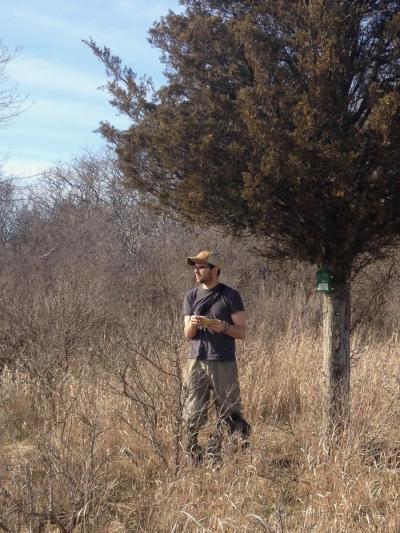The National Socio-Environmental Synthesis Center (SESYNC) is pleased to welcome Dr. Chris Field as a new Postdoctoral Fellow. Chris received his PhD from the University of Connecticut's Ecology and Evolutionary Biology department in 2016. Learn more about our new researcher:

Name: Chris Field
PhD: Ecology and Evolutionary Biology, University of Connecticut
Hometown: Hartford, Connecticut
SESYNC Project: Integrating social, ecological, and evolutionary factors to improve understanding of tidal marsh ecosystem responses to sea level rise
How would you describe your primary field of study?
I’m a conservation biologist, trained in ecology and evolutionary biology departments, but I am increasingly straying outside of my main area of expertise to address the various social dimensions of coastal conservation. I am trying to push myself toward research that is more integrative, and therefore better suited to address the complexity of doing conservation in the real world. Part of this push is learning more about tools and approaches, from across disciplines, that are available to address the types of questions I am interested in, which might lead me into areas that can’t be as easily classified as ecology or social science.
What are the broad questions you are interested in studying?
I’m interested in better understanding how coastal ecosystems are responding to sea level rise, with an eye toward generating knowledge that can improve coastal conservation. My interests have led to research that quantifies ongoing vegetation shifts, projects bird population dynamics, and develops conservation planning tools that can help practitioners navigate the complex trade-offs associated with coastal land protection. One of the largest remaining gaps in our understanding of coastal ecosystems under sea level rise, however, is the human component. Half of the world’s population lives in coastal areas, yet relatively little is known about the impact their behavior will have on the future of coastal ecosystems. Going forward, I hope to make this human component an integral part of all of my research questions so that the resulting ecological-social synthesis will generate knowledge that contributes to closing this gap.
What inspired you to choose this field of study?
I’ve been interested in dinosaurs (which led to my passion for birds) and marine biology for most of my life, so I was sold on being an ecologist once I learned that it was a path to studying these things for a living. My interest in the human dimensions of ecosystems grew out of necessity. Working at a conservation non-profit for several years taught me that the human component is often one of the largest determinants of success. Or put more succinctly, bird conservation is often 90 percent about people and 10 percent about birds. It’s exciting to be doing science at a time where the boundaries between disciplines are becoming fuzzier and there is value being placed on research that is designed to have more immediate relevance to pressing conservation and policy issues.
Can you briefly describe your proposed SESYNC postdoctoral project?
Much of my research to this point has been focused on one component of coastal ecosystems at a time—vegetation, birds, private landowners. There have been few efforts to formally integrate these factors to elucidate the big picture. This lack of integration can make even seemingly simple questions hard to answer. For example, will saltmarsh sparrows survive a century of sea level rise? A bird ecologist might answer this question using population models based on the vital rates of saltmarsh sparrows. But sparrow population viability might also depend on the vegetation shifts in saltmarsh ecosystems, whether the sparrows can evolve quickly enough, and the behavior of millions of coastal landowners, all of which are complex processes themselves. To truly address saltmarsh sparrow extinction with the confidence needed to use the results for decision making, these population models must incorporate these other ecological, evolutionary, and social factors, including any uncertainty they may introduce. At SESYNC, I will be developing population models that integrate these socio-ecological factors, and I will use these models to begin answering general questions about how best to conserve coastal ecosystems in the face of sea level rise.
Why is SESYNC the right place to undertake this research?
I was interested in working in an environment that encourages collaboration, integrative thinking, and interacting with researchers from other disciplines who may be working on similar issues or questions, but in different ways. SESYNC fosters this type of environment and is the only research center of its kind in the socio-environmental realm. Being exposed to a diversity of expertise and ways of thinking can often influence research in unexpected ways, and I’m excited to see how working at SESYNC influences my research going forward.
What are you reading right now?
I’m currently listening to the audiobook for Harry Potter and the Deathly Hallows because in my free time I’m trying to teach myself how to paint in watercolors.